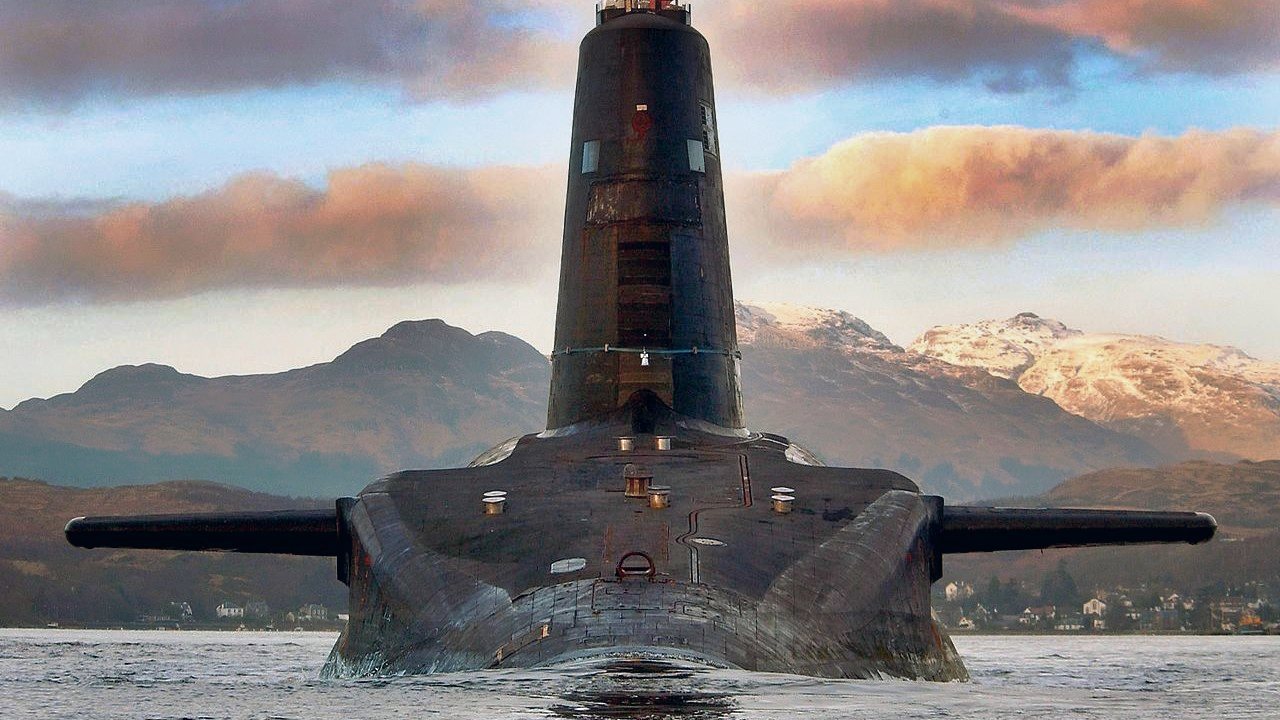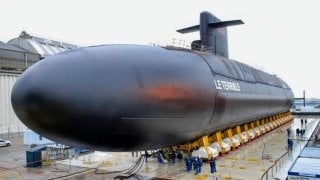2 Nuclear Missile Submarines Collided (Armed with Hundreds of Nuclear Weapons)
In February 2009, the British HMS Vanguard and French Le Triomphant, both nuclear-powered ballistic missile submarines, collided in the Atlantic Ocean during routine patrols. The incident raised serious concerns about naval safety protocols and the lack of communication between allied nations operating stealth vessels in close proximity.
What You Need to Know: In February 2009, the British HMS Vanguard and French Le Triomphant, both nuclear-powered ballistic missile submarines, collided in the Atlantic Ocean during routine patrols. The incident raised serious concerns about naval safety protocols and the lack of communication between allied nations operating stealth vessels in close proximity.

-Whistleblower William McNeilly later alleged that equipment failures and crew errors aboard the Vanguard contributed to the collision and that a cover-up ensued. This event underscored the potential catastrophic consequences of submarine collisions, especially between nuclear-armed vessels.
-The article also draws parallels to recent incidents involving U.S. and Chinese submarines, emphasizing the need for improved communication to prevent escalations that could lead to environmental disasters or even war.
In February 2009, an unprecedented and nightmarish event occurred in the depths of the Atlantic Ocean: two nuclear-powered ballistic missile submarines belonging to France and the United Kingdom collided with each other. The ships involved were the British Royal Navy’s HMS Vanguard and the French navy’s Le Triomphant.
The Collision
The collision happened in the early hours of 3 February 2009. The two subs were conducting routine patrols. At some point, in the mid-Atlantic, the two nuclear-powered submarines crossed paths and crashed into each other.
This catastrophe was the result of a combination of factors, but the most damning one of all comes from a Royal Navy submariner, William McNeilly, who decided to become a whistleblower. According to this whistleblower, the accident was likely the result of the British submarine which had been subject to “massive equipment failures, crew errors, and lax standards” onboard the HMS Vanguard.
Indeed, the official account provided to the public by the British government (and backed up by the French government), according to McNeilly, was far less caustic than the event actually had been. In fact, according to the whistleblower testimony, the British nuclear submarine was mere moments away from exploding (which would have ignited the ship’s nuclear reactor, causing all kinds of problems for the world).
The whistleblower account details how the FNS Le Triomphant had bashed out a “massive chunk” from the HMS Vanguard after which the French sub “grazed down the side of” the Vanguard. From there, “compressed air bottle groups had been dislodged by the collision and ‘were hanging off and banging against the pressure hull.’ The submarine had to return to base slowly because ‘if one of the [High Pressure Air] bottle groups exploded it would’ve created a chain reaction and sent the submarine plummeting to the bottom.’”

A “massive cover-up of the incident” soon followed.
According to McNeilly the Vanguard had become the poster child in the failing British Royal Navy (an issue about which this author has documented repeatedly in these pages) of mismanagement, lax discipline, and poor seamanship.
Before its collision with the Le Triomphant, there was another cover-up involving the Vanguard pertaining to a “deep depth incident” in which the HMS Vanguard “dived far beyond a normal safe depth. A combination of high-water pressure and the submarine’s low speed made it difficult for the submarine’s hydroplanes [to] generate enough lift to raise the submarine, and ballast water could not be pumped out fast enough to allow the submarine to rise.”
In essence, well before the 2009 collision, the Vanguard was almost lost due to poor seamanship. Yet, the Royal Navy, rather than address the problems, chose to cover it up and continue operating as though everything were normal.
Thankfully, the incident led to a review of submarine operations and safety protocols by both the British and French navies. It further highlighted the need for improved communication and coordination between allied nations operating in the same waters.
Although, the presence of a “massive cover-up” being enacted immediately upon the Vanguard’s return to port is unacceptable and begs the question as to whether the Royal Navy and French Navy really learned the right lessons or if they just figured out how to downplay things better.
The Subs Involved
Britain’s HMS Vanguard was the lead boat in the Vanguard-class ballistic missile submarine. It displaced 16,000 tons when submerged. It registered a length of around 149.9 meters, or 492 feet. Its beam was 12.8 meters (42 feet).
More importantly, though, the Vanguard’s propulsion system consisted on of one nuclear reactor, two steam turbines, one shaft and 20,000 ship-based horsepower. With this engine alignment, the Vanguard could reach a top cruising speed of 25 knots (or 29 miles per hour) when submerged. She carried a crew of 135.
As for armaments, this particular sub carried 16 Trident II D5 ballistic missiles and had four torpedo tubes for Spearfish torpedoes.

On the other end of the collision was France’s Le Triomphant, the lead boat of the French navy’s Triomphant-class ballistic missile submarine. This boat displaced a total of 14,335 tons when submerged. She had a length of 138 meters (453 feet), a beam of 12.5 meters (41 feet), making her slightly smaller than the Vanguard.
Like her British counterpart, the Triomphant also relied upon a single nuclear reactor to power two steam turbines with one shaft, giving the boat 15,000 ship-based horsepower. So, she was slightly less powerful than the Vanguard.
As for speed, she topped out at 25 knots—29 miles per hour—just like the British submarine did.
The Triomphant carried 15 M45 ballistic missiles and had four torpedo tubes for F17 torpedoes.
This incident on the High Seas between two allied nations that simply were not aware that each other had submarines operating in the same Area of Responsibility (AOR) could have been far worse than it was. The two submarines, as you have read, were nuclear-powered. Thus, these boats could have become like Chernobyl under the waves.
Thankfully, that fate was avoided. But this incident was a clear wake-up call.
Both Britain and France (and the rest of NATO) have all updated their policies for coordinating with allied foreign navies to ensure nothing like this incident occurs.
Yet, there are plenty of other parts of the world where nuclear submarines belonging to navies that do not get along with each other operate frequently.
Implications for Sino-American Interactions Beneath the Sea
Just recently, in fact, the USS Connecticut is believed to have crashed into an undersea mountain (seamount) in the crowded South China Sea while it was possibly conducting a covert surveillance mission of China’s secretive naval base at Hainan Island.
It was a major source of embarrassment for the US Navy because, the incident not only revealed what the Connecticut was up to but it also put a dent in the Navy’s limited Seawolf-class fleet.
The Connecticut will not return to service for another year. What’s more, it was quite a propaganda boon for China. Beijing rubbed salt in the wound by claiming—erroneously—that the Connecticut had created an unspecified “environmental disaster.”
Shortly thereafter, rumors abounded that China lost a Type 093 Shang-class nuclear submarine in the Taiwan Strait. It was never confirmed but this came on the heels of the Connecticut incident. Just imagine the nightmare scenario of the Connecticut had collided with a Chinese nuclear-powered Shang-class submarine. It would have been radioactive nightmare fuel for the region.
Thus, the need for stealth is naval engagements should be well understood but it must also be stressed that, in the nuclear age, such secrecy could lead to truly devastating consequences unless some form of modus vivendi is crafted between Washington and Beijing to deescalate certain crises.
This was done throughout the Cold War.
The Chinese, sadly, continue to rebuff American requests to create a reliable backchannel between the two superpowers.
France and Britain are key allies and the incident involving their submarines in the Atlantic in 2009 was relatively isolated. No casualties were reported and the two crews could aid each other and then their governments could cordially assess what had happened.
A Sino-American collision, which is likely to occur given the tension and interactions thus far between the two powers, could either lead to an environmental catastrophe. Or worse, it could lead to a world war.
Author Experience and Expertise: Brandon J. Weichert
Brandon J. Weichert, a National Interest national security analyst, is a former Congressional staffer and geopolitical analyst who is a contributor at The Washington Times, the Asia Times, and The-Pipeline. He is the author of Winning Space: How America Remains a Superpower, Biohacked: China’s Race to Control Life, and The Shadow War: Iran’s Quest for Supremacy. His next book, A Disaster of Our Own Making: How the West Lost Ukraine, is due October 22 from Encounter Books. Weichert can be followed via Twitter @WeTheBrandon.
All images are Creative Commons or Shutterstock.
From the Vault
Russia Freaked Out: Why the U.S. Navy 'Unretired' the Iowa-Class Battleships
Battleship vs. Battlecruiser: Iowa-Class vs. Russia's Kirov-Class (Who Wins?)


